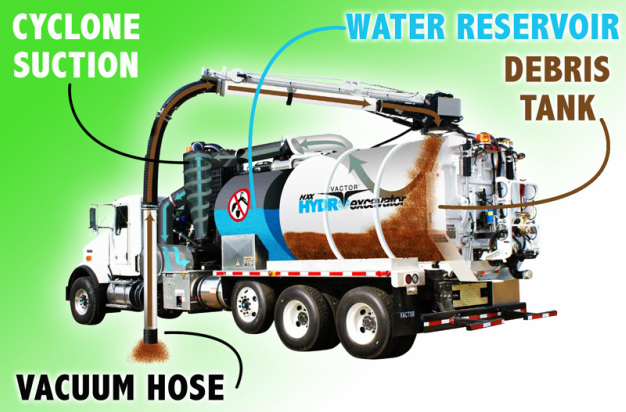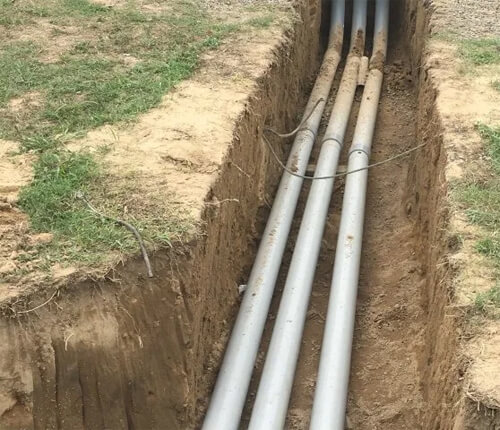Benefits and Applications of Hydro Excavation
Learn the basics, and what hydro excavation is used for.
Posted 17:15 June 07, 2023
Last Updated 17:15 June 07, 2023
Hydro excavation is a non-destructive digging method that utilizes a combination of high-pressure water and a vacuum system to safely excavate soil and debris. It is commonly used in various industries for a range of applications. Here are the basics of hydro excavation, along with examples of three applications and three benefits:

High-pressure water
A hydro excavation system employs a high-pressure water jet to break up the soil or material being excavated. The water is delivered through a handheld wand or nozzle, and its force is adjusted according to the excavation requirements.
Vacuum system
Once the soil or debris is loosened by the water jet, a powerful vacuum system is used to extract the resulting slurry into a debris tank. This process ensures that the excavation site remains clean and free from obstructions.
Non-destructive method
Unlike traditional excavation techniques that rely on heavy machinery or manual digging, hydro excavation is non-destructive. It minimizes the risk of damaging underground utilities, pipes, cables, or other sensitive infrastructure, making it a safe and efficient method.
Utility line exposure
One of the primary applications of hydro excavation is to expose utility lines. By precisely directing the water jet, operators can safely uncover buried pipes, cables, or other utilities without the risk of damage. This is particularly useful during construction or repair projects, preventing accidents and reducing downtime.
 Slot trenching
Slot trenching
Hydro excavation is also used for slot trenching, which involves digging narrow trenches for various purposes, such as installing pipes or cables. The precise control offered by hydro excavation ensures that the trench is accurately sized and minimizes the disturbance to the surrounding area.
Daylighting
Daylighting refers to the process of exposing underground infrastructure for inspection or maintenance purposes. Hydro excavation is employed to remove soil and debris around these structures, providing visual access to assess their condition and carry out necessary repairs.
Safety
Hydro excavation significantly reduces the risk of accidental damage to underground utilities, minimizing the potential for gas leaks, water line ruptures, or electrical hazards. It enhances overall job site safety by avoiding costly accidents and ensuring worker well-being.
Precision and efficiency
Hydro excavation allows for precise digging in targeted areas, ensuring minimal disturbance to the surroundings. The non-destructive nature of the process enables operators to excavate with accuracy, reducing the need for extensive repairs and cleanup. This precision translates into increased efficiency and cost savings.
Environmental friendliness
Compared to traditional excavation methods, hydro excavation is more environmentally friendly. It produces less noise, dust, and vibration, reducing the impact on the surrounding environment. Additionally, the use of water instead of mechanical force minimizes soil erosion and disturbance, making it a sustainable option for excavation projects.
These are just a few examples of the applications and benefits of hydro excavation. The technique is versatile and widely adopted across industries where safe and precise excavation is essential. If you have an upcoming municipal, commercial, or residential project, contact Hole Hogz and learn how we can help you meet your deadlines, improve site safety, and help deliver an exceptional project to the customer. We service Las Vegas, Henderson, Boulder City, and most parts of Clark County Nevada.

Basics of Hydro Excavation
High-pressure water
A hydro excavation system employs a high-pressure water jet to break up the soil or material being excavated. The water is delivered through a handheld wand or nozzle, and its force is adjusted according to the excavation requirements.
Vacuum system
Once the soil or debris is loosened by the water jet, a powerful vacuum system is used to extract the resulting slurry into a debris tank. This process ensures that the excavation site remains clean and free from obstructions.
Non-destructive method
Unlike traditional excavation techniques that rely on heavy machinery or manual digging, hydro excavation is non-destructive. It minimizes the risk of damaging underground utilities, pipes, cables, or other sensitive infrastructure, making it a safe and efficient method.
Applications of Hydro Excavation:
Utility line exposure
One of the primary applications of hydro excavation is to expose utility lines. By precisely directing the water jet, operators can safely uncover buried pipes, cables, or other utilities without the risk of damage. This is particularly useful during construction or repair projects, preventing accidents and reducing downtime.
 Slot trenching
Slot trenchingHydro excavation is also used for slot trenching, which involves digging narrow trenches for various purposes, such as installing pipes or cables. The precise control offered by hydro excavation ensures that the trench is accurately sized and minimizes the disturbance to the surrounding area.
Daylighting
Daylighting refers to the process of exposing underground infrastructure for inspection or maintenance purposes. Hydro excavation is employed to remove soil and debris around these structures, providing visual access to assess their condition and carry out necessary repairs.
Benefits of Hydro Excavation
Safety
Hydro excavation significantly reduces the risk of accidental damage to underground utilities, minimizing the potential for gas leaks, water line ruptures, or electrical hazards. It enhances overall job site safety by avoiding costly accidents and ensuring worker well-being.
Precision and efficiency
Hydro excavation allows for precise digging in targeted areas, ensuring minimal disturbance to the surroundings. The non-destructive nature of the process enables operators to excavate with accuracy, reducing the need for extensive repairs and cleanup. This precision translates into increased efficiency and cost savings.
Environmental friendliness
Compared to traditional excavation methods, hydro excavation is more environmentally friendly. It produces less noise, dust, and vibration, reducing the impact on the surrounding environment. Additionally, the use of water instead of mechanical force minimizes soil erosion and disturbance, making it a sustainable option for excavation projects.
These are just a few examples of the applications and benefits of hydro excavation. The technique is versatile and widely adopted across industries where safe and precise excavation is essential. If you have an upcoming municipal, commercial, or residential project, contact Hole Hogz and learn how we can help you meet your deadlines, improve site safety, and help deliver an exceptional project to the customer. We service Las Vegas, Henderson, Boulder City, and most parts of Clark County Nevada.
